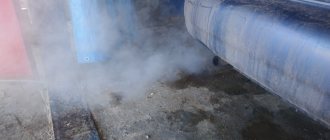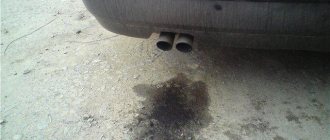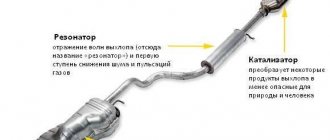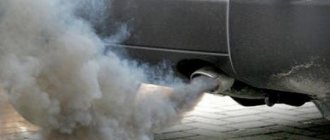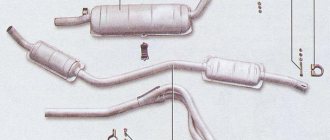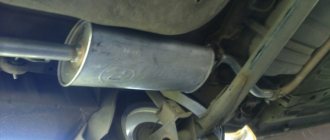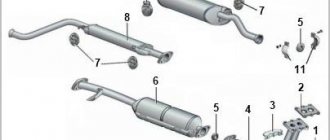Very often, vehicle owners are faced with the problem of condensation appearing in the exhaust pipe. As a result, water appears in the muffler and white smoke (steam) may come out of the exhaust pipe when the engine is running.
Note that the phenomenon of water in the exhaust pipe is quite normal in some cases. However, not always. Often this is a signal of malfunctions of individual systems and components of the car. Next, we will look at why it drips from the muffler, what is leaking out, water or condensation, and also what kind of breakdowns are indicated by the situation when it is clearly steaming from the muffler.
Where does water come from in a car exhaust system?
The reason for this is condensate - a liquid that has changed from a gas state due to cooling or compression. Its appearance is due to temperature differences: a muffler heated from the inside is not cooled as intensely as from the outside. In this case, moisture is formed only after the engine is stopped. As soon as the car stalls, dewdrops will begin to settle in the exhaust pipe. In winter, the accumulated condensate also freezes. So the ice build-up gradually increases, forming a traffic jam in the car muffler.
Physical processes of condensation formation
The composition of the fuel is the basis from which moisture appears inside the exhaust pipe. Gasoline is a mixture of light hydrocarbons. When burned, they produce a variety of gaseous substances, including water vapor. Regardless of the quality of the fuel, there will always be moisture in the muffler. But “premium” gasoline emits less water than cheap gasoline. At a certain air temperature, these vapors settle. This is how condensation forms: the exhaust pipe quickly cools from the outside, but the warm air remains inside for a long time.
Consequences of condensation release
Drops that appear inside the exhaust pipe after stopping the engine flow down and accumulate in the cylindrical resonator housing. The next time you start a cold engine, they are squeezed out by exhaust gases, as a result of which water drips from the muffler until the tract warms up. The remaining liquid evaporates from the hot pipe and is thrown out along with the smoke, the outflow stops.
What are the consequences of water accumulation inside the exhaust system:
- If the car is stored in an open parking lot in winter, the moisture will be captured by frost after cooling. Ice will appear in the pipe, partially blocking the flow area.
- Freezing of water in the muffler and resonator tanks reduces the service life of these elements. Because ice formation is accompanied by expansion, metal walls and welds are subject to tensile stress.
- The exhaust system, made of ferrous metal with an anti-corrosion coating, runs the risk of rusting over time. Condensate contains sulfur and other aggressive substances that cause corrosion. Stainless steel pipes are not susceptible to chemical attack.
Note. An ice plug that completely blocks the passage of flue gases is a rather rare occurrence. Normal moisture release processes described in the previous section do not lead to similar consequences. The maximum that can happen is a build-up of icicles at the end of the pipe.
Since condensation always appears in the exhaust pipe in all cars, the difference in exhaust system wear is almost unnoticeable. Gas ducts and tanks made of ferrous metal last from 20 to 50 thousand kilometers, and any fistulas that arise can be repaired using conventional welding and thus extend the life of the elements. Stainless steel lasts twice as long – up to 100 thousand km.
Why does a lot of water collect in the muffler?
Noticing condensation dripping from the exhaust pipe, an inexperienced car owner either panics or is perplexed. Rushing to the nearest service station is not the smartest idea. Several factors contribute to the accumulation of moisture in the inside of the pipe. You need to understand them in more detail:
- driving in winter - the difference in temperature outside the muffler and inside it makes itself felt;
- infrequent use of the car - short short trips are fraught with increased condensation;
- modern exhaust gas purification – their design entails side effects.
When driving in winter
The cold season is the best condition for the formation of condensation in the muffler. The air temperature outside the exhaust pipe is much lower than inside it. So the moisture does not evaporate, but settles in a liquid state. Automatic warming up of the car partially solves the problem with condensation. But moisture still remains on the cold components of the exhaust system, because the idle speed is not so high as to blow it out with a stream of gases. Therefore, water settles inside the muffler, accumulating with each new heating.
When using the car infrequently
The shorter the trips, the worse the muffler warms up, which means less intense evaporation of moisture. It will settle inside the exhaust pipe in larger volumes than during long-term operation. Car owners who make long trips experience less difficulty with condensation in the muffler. The same cannot be said about those who use their iron horse only for short “home-work-home” forays.
In cars with modern exhaust gas cleaning systems
Due to the catalyst (emission system), condensation can flow while driving the car. A lot of substances come out of the cylinders and are sent to the exhaust manifold. The process is accompanied by the release of nitrogen oxides, carbon monoxide, unburned hydrocarbons, carbon dioxide, oxygen and water. Only the last three elements are harmless to humans. All the rest go to the car's catalyst, where they are oxidized by platinum and palladium. This is how carbon dioxide and water vapor are formed. The latter remains inside the muffler.
How does moisture get inside the muffler?
In the vast majority of cases, splashes of water escaping from the exhaust pipe do not indicate any failure and do not pose a danger to the “health” of the car. Splashes can be observed on almost all cars, regardless of class and model. The reasons for the formation of moisture lie in ordinary physical phenomena and chemical reactions occurring inside the engine and exhaust tract:
- Condensation resulting from contact of hot surfaces with cold outside air.
- The release of water as a product of the chemical reaction of hydrocarbon fuel combustion occurring in the cylinders of the power unit.
- During residual afterburning of combustible gases, water vapor also forms inside the catalytic converter.
Each reason requires detailed explanation. In the first case, moisture forms after stopping the running engine, when the exhaust tract has become thoroughly heated. Water vapor suspended in the air condenses upon contact with hot surfaces. The more humid the outside air and the greater the temperature difference, the more intense condensation occurs. This is why much more liquid flows out of the pipe in winter than in summer.
Reference. The greatest amount of condensation occurs during periods of rain and fog, when the air is oversaturated with moisture.
Water vapor is also a product of combustion of gasoline, liquefied gas and diesel fuel. When oxidized, a hydrocarbon compound disintegrates with the release of heat. As a result of a chemical reaction, 2 substances are formed - carbon dioxide and water, which evaporate at the time of combustion. The steam is released through the valves into the exhaust pipe, where it partially condenses.
Since the combustion conditions of gasoline are not very ideal, unburnt carbon monoxide (CO) is formed in the chambers, which is sent along with the exhaust to the catalyst. There the final oxidation and combustion of gasoline vapors occurs, again releasing water.
Is condensation in a car dangerous?
Moisture settled in the muffler is a sign of proper operation of the internal systems of the car. Although such a phenomenon does not pose a radical danger, it would be thoughtless to turn a blind eye to it. The main reason for this is corrosion. Experts at domestic service stations claim that exhaust gases are no less aggressive than condensate. But water in a car muffler is still a potential threat, just like any metal liquid. The same applies to the gas tank, engine, and interior - in these places moisture sometimes accumulates in the same volumes as in the muffler.
In addition to the fact that water will splash spectacularly from the exhaust pipe, the car owner will also face a banal inconvenience. During a trip, few people will ignore the gurgling and “spitting” sounds made by the muffler, and in the cold season an additional nuisance appears - an ice jam. Frozen condensation can simply block the exhaust outlet, causing the car to not move.
If water flows from the exhaust pipe on a warm engine
Moisture can get from the fuel tank into other vehicle systems. If the neck of the oil filler cap is stained with a white coating, then condensation is present in the engine itself. If the gasket is damaged, similar marks remain near the valves. Even antifreeze mixed with oil can have the same appearance. In any case, moisture in the engine is a risk of increased heating.
The source of the problem lies in leaky car parts, but if these damages are not detected even after a thorough inspection, then it is too early to worry. Condensation may occur due to the mixing of water and oil on the engine. Ordinary moisture removers will help get rid of it. When interacting with water, these substances enter into a chemical reaction. This creates compounds that burn during engine operation without harm to the insides of the car.
If black liquid drips
The concern begins from the moment when the condensation flowing out of the exhaust pipe shimmers with an unusual hue. It can be black, blue, and sometimes yellow-green. But the color of moisture from the muffler should not puzzle the car owner. On the contrary, this shade will give an understanding of the nature of the problem:
- Some parts of the car are very worn. There may be an oil leak or the coolant is turning the moisture from the muffler an unusual color.
- Cheap, low-quality fuel with a high content of additives. The latter, as a rule, do not burn out, but come out of the muffler along with condensate.
- A high concentration of soot in gasoline turns the moisture yellow-green.
- Soot has settled inside the muffler, causing black water to drip from the exhaust pipe.
Consequences of condensation release
Due to frequent use of the car, the liquid simply does not have time to evaporate; as the unit warms up, steam begins to be released, and then water drips from the exhaust pipe, but with the engine in full working order at the desired temperature, the problem should disappear. Condensation that naturally accumulates in the muffler is not as dangerous as it might seem at first glance, although it does not bring any benefit. The consequences of its presence in the exhaust system are as follows:
- When a car is parked in open parking lots in winter at sub-zero temperatures, the liquid inevitably freezes. A crust of ice appears in the pipe, which can partially or even completely block the passage, preventing the exhaust gases from escaping. The exhaust gases, returning, deplete the fuel mixture, as a result of which the car may simply not go anywhere. An ice jam is a rare occurrence; usually, leaving a car in the cold leads to the formation of icicles on the pipe;
- Freezing of water reduces the service life of parts of the exhaust system; as a result of expansion caused by the appearance of ice, a pipe or resonator may even rupture;
- Moisture plays an important role in the onset of corrosion, but rust is caused not so much by the liquid accumulating in the muffler, but by other reagents contained in the exhaust and having an aggressive effect.
Since the exhaust system can be made of different materials (ferrous metal, aluminum, stainless steel), it will serve differently. Stainless steel is the most durable; subject to natural exposure to moisture and exhaust gases, the pipe will last up to 100,000 km. vehicle mileage.
How to prevent liquid from appearing in the exhaust pipe
Whether it’s a luxury car or an old car, this will not protect you from the laws of physics; condensation forms in all of them. The same applies to the quality of gasoline - there will be moisture in all brands, albeit in different volumes. But if water gets into the muffler, then effective recommendations should be followed. Tested by time and practice, they will help get rid of condensation:
- Store the car inside the garage when cold weather sets in. Many car owners prefer to leave their vehicles in the cold, not wanting to waste time walking from home to garage - in winter this is a gross disrespect for their car. If you park it in a warm room at night (for example, in a garage), then in the morning it will take less time to warm up.
- Auto warm-up This feature is available in most modern cars. It is important to set it up correctly so that the muffler warms up along with the car. Otherwise, there is no guarantee that even when this system is activated, the exhaust pipe will not be clogged with icy condensate. This applies to both cars with injectors and carburetors - however, the latter warm up more slowly.
- Pay attention to the parking spot. If the car is parked on a slope towards its muffler, then water flows out of it faster.
- Arrange at least weekly long trips. This is an effective prevention against the formation of an ice plug from frozen moisture.
- Insulate the exhaust pipe of a car if there is neither a garage nor a heating function. Non-flammable heat insulators or liquid heating are suitable for this.
- Change gas station. Poor quality fuel also contributes to the formation of condensation inside the muffler.
- Drill a tiny hole in the resonator. An old and controversial method that ensures the free flow of water. The disadvantage of this method is that this same hole will serve as a catalyst for the development of corrosion.
Where else can water accumulate?
The muffler is not the only place where condensation can accumulate. Some internal systems of the machine are also susceptible to this phenomenon. In particular, these are the fuel, oil and cooling systems. Don't be surprised if you find drops of water inside the interior or even in closed areas of the body.
There is one big problem with the appearance of water in internal systems: the moisture may not reach the muffler, and you simply will not notice it. Meanwhile, the fluid will gradually accelerate the wear of parts, which may lead to failure. To avoid this, look under the hood of your car as often as possible and do not hesitate to use the services of a service station.
Condensation in the gas tank
If your car starts with difficulty or there are interruptions in engine operation, it means that condensation has formed in the internal systems of the car. Moisture may appear in the gas tank if the gasoline you use is of poor quality and has a high water content. This product is often found at old or small gas stations. Pay attention to the cost of fuel at the gas station where you usually fill up. If it is much lower than the city average, don’t rush to rejoice. Most often, the reason for the price reduction is an artificial increase in the octane number using additives. It is much safer to use gas stations of well-known companies.
Video
Found an error in the text? Select it, press Ctrl + Enter and we will fix everything!
Many motorists are faced with the problem of condensation in the exhaust pipe and, as a result, water droplets appearing in the muffler. Sometimes this is a normal phenomenon, but it happens that condensation in the muffler is a kind of alarm beacon indicating a malfunction of the internal systems of the car.
Where does water come from?
The main problem with condensation is invisibility. Most of us simply do not pay attention to its appearance until the amount of liquid becomes noticeable to the naked eye. In winter, when water constantly changes from one state to another, this is a particularly dangerous phenomenon. But in the summer, liquid dripping from the exhaust also does not bode well.
Condensate itself is basically water, which is formed during the transition from a gaseous state to a liquid state. In nature, it is constantly formed, but does not cause damage. But it can become a problem for a car. It can form not only in the muffler, but also in the internal systems of the car: fuel, oil, and also in the cooling system. It also accumulates in the cabin and closed areas of the body. In any case, there is harm from this. But its degree differs in each individual case.
The moment you turn off the engine, condensation begins to form in the exhaust pipe. Even if the car is new and fully working. This is a natural phenomenon from which it is impossible to protect yourself. The outside of the entire system cools much faster than the inside. Small accumulations of moisture appear in the muffler, which freeze in a short time and cover the “insides” with an ice crust. Experts say that this phenomenon does not cause much harm in this case, but many drivers are wary of it.
The fact is that a small accumulation of moisture in the muffler during active use of the car may, on the contrary, indicate its serviceability and proper operation. Here are some examples of how and why condensation occurs:
- With active use of the car, it will always form. In the cold season, car trips and, of course, engine heating become the main reason for its formation;
- Cars with automatic start are more susceptible to this phenomenon. The pipe warms up in a maximum of 20 minutes, the frozen condensate melts, but does not yet have time to evaporate, and splashes out under the flow of exhaust gases.
- If you press the gas pedal sharply, fluid will come out of the exhaust pipe more actively due to greater pressure in the exhaust.
Conclusion: if in winter at sub-zero temperatures water drips from the muffler, and the amount is small, this is not a reason to panic and not a reason to go to the nearest service station to carry out thorough diagnostics and repairs.
What dangers does condensation pose?
Once formed in the muffler, it will cause virtually no harm. Although over time it becomes the main cause of corrosion. But in winter, the corrosion process occurs much more slowly than in the warm season. If in winter the car is not warmed up at least once a day, the amount of frozen condensate in the exhaust may increase to such a level that the car simply will not start after a couple of days of inactivity. To avoid such troubles, some advise drilling a small hole in the resonator to allow unnecessary moisture to drain. However, this solution is not the best. The problem is that the metal around the hole you make will corrode much faster. As a result, after a short amount of time you will have to completely change the exhaust pipe. Agree, if such a method were effective, manufacturers themselves would use it at the manufacturing stage.
What's the result?
As you can see, the formation of condensation in the muffler in small quantities is not a dangerous phenomenon, especially in the cold season. However, the appearance of water and thick steam often indicates a breakdown of the internal combustion engine if there is “hot” steam from the exhaust, intensely and constantly.
We also recommend reading the article on why water in engine oil is a serious problem. In this article, you will learn about the reasons why water gets into the engine oil, as well as how to determine if water is getting into the engine oil.
This symptom cannot be ignored, as in some cases it may indicate quite serious damage. In such a situation, the engine and its systems require comprehensive diagnostics and high-quality repairs.
Otherwise, it may get to the point where the motor knocks or jams. As a result, an expensive “overhaul” or complete replacement of the power unit will be required.
Causes of condensation in the muffler
So why does condensation appear in the muffler, especially in winter? There are three main reasons explaining this phenomenon.
Temperature difference
The most common reason, which is relevant for the cold season, is that due to the condensation process, well known from school physics courses, water vapor in the air at a cold temperature, when heated, turns into liquid water , which settles on the surface of parts, in this case muffler. That is, when in winter at subzero temperatures you begin to warm up the car, the walls of the muffler and exhaust pipe, due to natural reasons, heat up, and condensation appears on their surface (including the inside).
Antifreeze getting into the cylinders
This phenomenon occurs when the cylinder head gasket burns out or a crack appears on the latter. An additional sign of a breakdown is the presence of thick white smoke even after warming up in a warm room (to do this, you need to find a room where the air temperature will be above +10°C). If the gasket or cylinder head is damaged, it is necessary to repair the damage as quickly as possible, since they are critical and can significantly damage the engine until it completely fails.
Poor quality gasoline
Another reason why condensation drips from the muffler may be the use of low-quality fuel, in particular, with large amounts of water. This in itself is very dangerous for the engine, since it can cause water hammer and other unpleasant consequences, even fatal, after which the car owner will be forced not only to overhaul the engine, but to completely change it. In particular, the crankshaft and cylinder-piston group may fail.
Accordingly, in order to avoid such situations, try to refuel at proven gas stations, and fill in not the cheapest, but more or less high-quality fuel. The second tip is to not drive fast through deep puddles or in the rain. Not only is this unsafe to drive, but it can actually harm your car's engine.
When should you be wary?
In some cases, the release of water indicates certain problems with the motor:
- the amount of condensate is too high;
- the flow does not end after the engine and exhaust system warm up;
- the flying drops have a distinct black color or leave oily stains on the asphalt.
If strong condensation comes from the exhaust, which does not stop when the engine warms up and is accompanied by white smoke, there is a breakdown of the cylinder head gasket (cylinder head). This means that the crack has connected the channels of the block's water jacket with the combustion chamber. Antifreeze penetrates the cylinders, evaporates from the high temperature and is thrown into the exhaust system. As a result, you observe the release of white steam and coolant, which has managed to partially condense.
Advice. If you discover a violation of the integrity of the cylinder head gasket, immediately begin repairing the power unit. Driving with this malfunction is unacceptable.
Both the color of the exhaust gases and the color of the condensate may indicate a specific problem. Black water from the muffler indicates a large amount of soot contained in the smoke and deposited on the inner walls of the pipes. There are two reasons for its formation:
- poor fuel combustion conditions (wear of the cylinder-piston group, problems with the fuel supply, ignition system, and so on);
- refueling with low-quality gasoline or diesel fuel.
There are cases when soot from unburned or low-quality fuel completely clogged the pipeline system, making it impossible to start the engine.
An oily puddle under the exhaust pipe may indicate wear on the cylinder-piston group or valve seals. Engine lubricant, penetrating into the cylinders, burns and is partially released into the flue and mixed with condensate. The problem is accompanied by bluish smoke, carbon deposits on the electrodes of the spark plugs and increased oil consumption in the engine.
Sometimes condensation turns an unusual yellow-green color. This color indicates a high sulfur content in the fuel, which is a sign of low quality.
Methods for eliminating condensation in the muffler
There are several ways to get rid of condensation in the muffler. If individual components and assemblies that are responsible for this phenomenon are faulty, then first of all it is necessary to eliminate the breakdown (replace the cylinder head gasket, check the operation of the catalyst), because condensation is just a sign, and the reason for its appearance lies much deeper. But if the car is in good condition, and the moisture on the surface of the muffler is caused only by the temperature difference on its walls, then you should not worry too much, because there are a number of effective methods that allow you to remove condensation from the muffler of a car.
- Try to park the car in such a way that its exhaust pipe is inclined from bottom to top . This will allow condensation from the muffler to escape outside before the freezing process. This is the simplest method, which however is not always feasible. Besides this, its effectiveness is low, especially in very severe frosts.
A large amount of moisture in the muffler can lead to difficulty starting the engine (regardless of its type), malfunction of the engine, and activation of the Check Engine warning light. In addition, a decrease in engine dynamics leads to tarring of the injection nozzles on injection engines. On carburetor engines, the throttle valve of the secondary chamber can become completely sour over the winter. And on diesel engines, the particulate filter can become clogged. This also leads to excessive fuel consumption.
If you rarely use your car in winter (for example, you just use it to go to work or to the store), it is still recommended to periodically (every few days or once a week) warm up the engine in order to remove as much condensation as possible from exhaust gas removal systems. Another option is to drive onto a country highway in order to “blow out the pots,” that is, drive at high engine speeds (not necessarily high speed, you can just use low gears). This will make it possible to expel excess moisture and soot from the vehicle exhaust system. Obey the speed limit and safe driving rules!
What not to do
Some car owners and craftsmen advise drilling the muffler to drain condensate out through the resulting hole. It’s worth mentioning right away that doing this is not recommended! There is a very simple reason for this. The fact is that after drilling the wall, the holes will be formed from metal, which is not protected from corrosion (unlike the remaining surface area). Therefore, over time, this will, on the contrary, lead to rusting of the hole . That is, you will get the opposite effect! Agree, if it were so simple, car manufacturers themselves would have done such a trick, and even with protection against the appearance of corrosion processes.
An exception may be cars that are operated in the Far North, for example, at temperatures from -30°C and below, using an auto-heating system that turns on periodically . In this case, there is indeed a risk that the condensate cools down and crystallizes extremely quickly, thus forming ice in the exhaust pipe. On Internet forums, owners of Renault Duster, Renault Laguna, Nissan X-Trail and some others use this approach due to the design features of their mufflers.
And remember that if you do decide to drill the muffler, then you need to do this using a drill with a diameter of about 3 mm, and make a hole at the lowest point of the muffler so that the liquid flows there.
Summarizing
In most cases, the problem of condensation does not pose a major threat to the exhaust system, since the muffler is often destroyed due to decomposition products of exhaust gases, and not condensation. So dripping water with a living, normally working catalyst is a natural, normal phenomenon. However, if a significant amount of moisture forms, problems with starting the engine and excessive fuel consumption may occur. Therefore, try to periodically drive the car at high speeds in frosty weather so that the muffler warms up well and naturally evaporates all the condensate. As for the holes in the muffler, it's up to you to decide. The conditions for making a decision are described above.
How to reduce the amount of moisture or steam when warming up
It is completely impossible to get rid of water that gets into the muffler, but you can reduce its amount if you perform a number of the following actions:
- make not only short, but also long trips by car;
- before turning off the already well-warmed engine, do a long release of gas;
- To allow condensate to escape, you can make a small hole in the muffler (resonator).
By the way, holes for draining condensate in mufflers on some vehicles are provided by the manufacturer. This solution allows you to increase the service life of exhaust system parts.
We also recommend reading the article on how to determine the condition of the engine by spark plugs. From this article you will learn what malfunctions carbon deposits on spark plugs may indicate, as well as what to look for when checking.
If there are no such holes, you can make them yourself. To do this you need to know how to make a hole in the muffler. Note that with a working internal combustion engine, the formation of condensation is not dangerous. But there is a nuance - accumulated moisture in the muffler cans, remaining inside for a long time, can lead to the formation of rust. As a result, there is a rapid failure of exhaust system elements.
The problem is solved by making a hole in the muffler. Before carrying out work, the car is placed on a pit or raised using a lift. Required materials and tools: drill and drill bits from 1.5mm to 2mm.
Carrying out the work in stages:
- Having found the rear “can” of the muffler, make a hole at the lowest point with a drill;
- As soon as liquid begins to flow out, immediately remove the power tool to the side;
- if necessary, make another hole from the bottom on the other side of the can.
This method is simple, but it is important to take into account possible freezing of the holes in winter. Also, in the place where the holes are drilled, corrosion can actively corrode the metal. In any case, if condensation from the exhaust pipe is a problem, drilling holes can help reduce the intensity of the moisture buildup.


